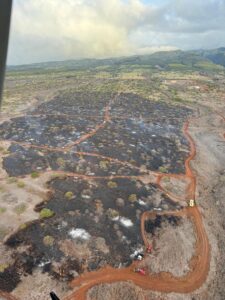Plan aims to save 44 endangered species in Maui Nui
They face loss of habitat, threats from predators and climate change
Federal officials are mapping out a roughly $6.5 billion plan to help bring back 44 endangered species across Maui Nui, including 40 kinds of plants, three tree snails and one yellow-faced bee.
All of the species in the U.S. Fish and Wildlife Service’s draft recovery plan face similar threats — habitat loss, introduced disease and nonnative and invasive predators like rats, cats and pigs. Climate change is also exacerbating and accelerating these threats across Hawaii and the Pacific Islands.
“Recovery plans are an important step towards the rehabilitation of a species,” Earl Campbell, Pacific Island Fish and Wildlife Office field supervisor, said in a news release Wednesday. “Hawaii is unique because many of the native and endemic species evolved for centuries in isolation, free from threats.”
Hawaii is home to 578 species protected under the Endangered Species Act, with many found nowhere else in the world. The 44 species covered in the draft plan are listed as endangered under the act and are currently at risk of extinction, according to the Fish and Wildlife Service.
The 40 endangered plants include grasses, herbs, shrubs and vines found throughout Maui Nui, with some potentially wiped out completely at this point, according to the draft recovery plan.
One of the three snail species, the Newcomb’s tree snail, is found on Maui, while two species of pupu kani oe, or the Lanai tree snail, are found on Lanai.
The hilaris yellow-faced bee has been found in coastal habitats on Maui, Molokai and Lanai.
The plan provides a road map for conservation officials to control threats in the habitats of the endangered species, document their population size, preserve some in safe locations such as a nursery or seed bank if needed and meet population benchmarks that will help remove the species from endangered lists.
“Conservation strategies include addressing threats of invasive species, disease and habitat loss that are being amplified by effects of climate change,” Campbell said. “These challenges showcase how important it is to continue working with our conservation partners, as we strive to preserve our native and endemic species for future generations.”
Plants are foundational to the unique ecosystems of the Hawaiian Islands, with many plants co-evolving in isolation with the archipelago’s endemic wildlife, the Fish and Wildlife Service said. The 40 plants addressed in the recovery plan are losing their habitat and populations to animals, disease and even other plants.
Introduced ungulates, like deer and other hooved mammals, are destructive to the native vegetation in all the occupied or suitable habitats of the 40 plant species as they create trails that damage native vegetation cover, destabilize substrates causing erosion, injure roots and seedlings through trampling, create gullies that contribute to flooding and promote invasion of nonnative species through transportation of seeds.
Invasive plant species, threats of fire and drought, disease and predation from rodents and insects also threaten the 40 plants.
Rapid ohia death is an example of a disease that poses an ongoing threat to ohia lehua, an important canopy tree in forest habitats that are home to endangered plants and animals. Killing individual trees as well as groups of trees, the disease is present on Maui and poses a significant threat to ohia on Lanai and Molokai if it were to become established on those islands, the Fish and Wildlife Service said. Other disease threats include myrtle rust and powdery mildew.
Yellow-faced bees, meanwhile, face threats such as introduced ants, which interfere with pollinators by consuming large quantities of nectar without pollinating the plant.
Preliminary cost estimates for recovery of the species top $6.5 billion, including:
• $1,646,260,000 to protect habitats and control threats in management units.
• $924,500,000 to control species-specific threats.
• $3,536,473,720 to expand the distribution of existing wild populations and establish new populations.
• $407,200,000 to conduct additional research essential to recovering the 44 species and restoring their habitats.
• $29,450,000 to implement regulations and policy to support species recovery.
If the recovery efforts are fully funded and followed as outlined in the plan, it could take 25 to 95 years to meet the recovery criteria depending on the species.
The Maui Nui draft recovery plan is available for public comment for 90 days. To view the plan, visit ecos.fws.gov/docs/recovery_plan/Maui_Nui_Draft_RP_20211217_Signed.pdf.
Copies on CD are also available by request from the U.S. Fish and Wildlife Service, Pacific Islands Fish and Wildlife Office, at 300 Ala Moana Blvd., Room 3122, Honolulu, HI 96850, or by calling (808) 792-9400.
Requests for more information or written comments can be mailed to the field supervisor at the Pacific Islands Fish and Wildlife Office in Honolulu by mail marked with “Attention: 44 Maui Nui Species Draft Recovery Plan.” Or, they can be emailed to megan_laut@fws.gov with “44 Maui Nui Species Draft Recovery Plan Comments” in the subject line.
Comments must be received or postmarked on or before May 16. All comments and materials received will become part of the public record associated with the recovery plan.
* Colleen Uechi can be reached at cuechi@mauinews.com.



